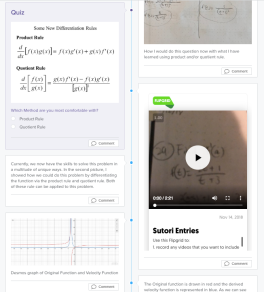Session Description
Metacognition – “thinking about one’s thinking” – has been linked to improved learning outcomes. Research has shown that metacognition promotes deeper learning and affects whether students can transfer and apply their knowledge to new scenarios. Teachers can scaffold metacognition by asking students to explain their thought process. By asking, “how did you figure that out?” or “talk through your solution,” teachers can help students reflect on the process and tease out the strategies they chose to use in solving problems. What’s more, by providing opportunities for students to revise and analyze errors, teachers help students see more clearly how their thinking has improved and oftentimes allows them to see the solution differently.
This session will examine specific examples using Pear Deck, Flipgrid, and Sutori. Participants will learn how to create student-paced Pear Deck activities with embedded Flipgrid prompts to create exercises that allow students to reflect on how they are understanding the new information they are receiving. Teachers can use multiple choice questions to do quick learning checks and then provide space for open-ended text responses for students to explain how they arrived at their solution, why they chose the answer they did, and if—once presented with some new knowledge—they would change anything. At the conclusion of the activity, teachers can use Pear Deck Takeaways to have students revise errors and talk about how their understanding of the topic has improved to help them arrive at a new solution to the problem. Having students evaluate how they approached problems done in the past is an important component of the learning process. As students reflect, they are forced to tap into prior knowledge to connect new ideas to things they already know. By actively reflecting on what they learned and how they learned it, students are able to grow their understandings beyond rote memorization. And in the reflection process, students become aware of holes in their knowledge. This awareness is a powerful component in helping students learn how to learn.
Sutori is another edtech tool that will be showcased in this session. Participants will be walked through an activity asking students to look back on past work and document how it directly relates to their new knowledge. Reflection is key to learning, and this project provides students the opportunity to form a deeper understanding of connections between the chapters being studied. As with the Pear Deck activity, Flipgrid is infused into this activity to allow students the opportunity to talk out their thought process directly to their webcam.
LINKS: Flipgrid to Verbalize Process
Flipgrid Student Videos for Test Prep: https://flipgrid.com/115ed5 
Blog Post: Using Flipgrid in Online AP Calculus to Allow Students to Verbalize Their Thinking Process
———-
Blog Post: Flipgrid Collab with @ADickie601’s Class — AP Calculus Final Review
———-
Video: Why & How I Use Flipgrid in my High School Math Classroom
LINKS: Documenting Reflective Thinking Using Sutori
 Sutori Exemplar: https://www.sutori.com/story/ap-calculus-trimester-1-project–JxudRDjhWRCUfb9fuYUPkScK
Sutori Exemplar: https://www.sutori.com/story/ap-calculus-trimester-1-project–JxudRDjhWRCUfb9fuYUPkScK
Blog Post: Documenting Growth & Reflecting on Connections Using Sutori with Embedded Flipgrid Responses
———-
Video: Using Sutori in Math Class
LINKS: Pear Deck Activities
 Pear Deck Optimization Activity: https://app.peardeck.com/student/toelaevnz
Pear Deck Optimization Activity: https://app.peardeck.com/student/toelaevnz
Blog Post: Using Pear Deck with Embedded Flipgrid Questions to Develop Deeper Connections
———-
Pear Deck Multiplication Activity: https://app.peardeck.com/student/tqyqeohxd
